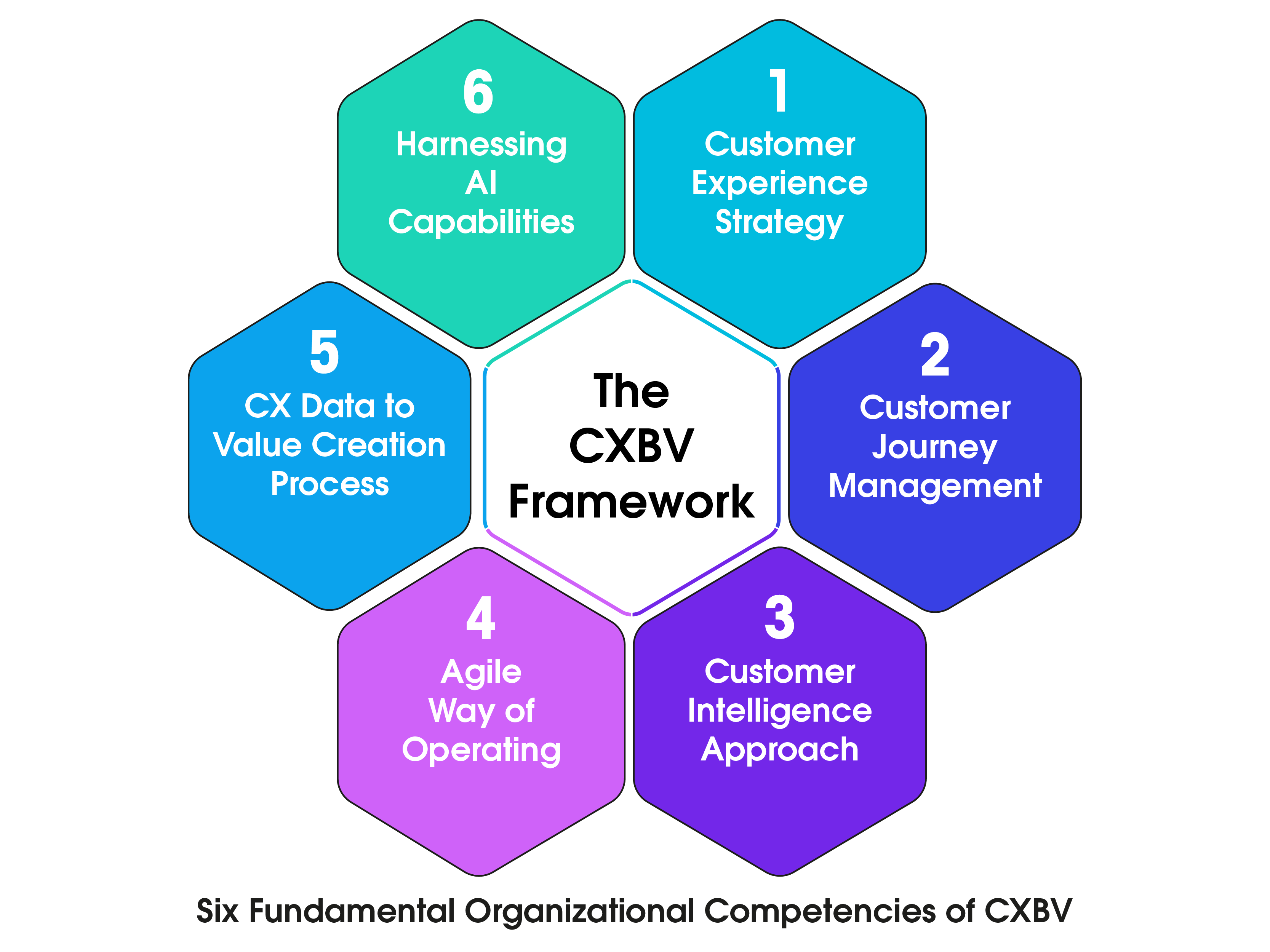0+
Case Studies
Across 3 Industries
The Customer Experience-based View (CXBV) Model
Case Studies
Across 3 Industries
Key Cap abilities
Identified
In an era where customers are empowered with more information and choices than ever before, their expectations for personalized, seamless, and memorable interactions have significantly increased.
The competitive landscape has shifted, and organizations are now competing to deliver superior customer experiences to gain a strategic advantage.
Customers experience management (CXM) has emerged as a significant aspect of business strategy, acknowledged for its role in fostering sustainable competitive differentiation.
In this context, the utilisation of artificial intelligence (AI) in CXM assumes paramount importance, as CX is one of the most influenced disciplines by the superior benefits and applications offered by AI, such as machine learning, natural language processing, and predictive analytics, enable businesses to analyze vast amounts of data, understand customer behaviors, and anticipate their needs.
Case Studies
Across 3 Industries
Key Cap abilities
Identified
As a result, organizations must adopt a comprehensive approach to managing and enhancing every touchpoint of the customer journey to meet and exceed these expectations. This has led organizations to ask the following questions:
The CXBV framework provides invaluable insights into the multifaceted nature of customer experience management (CXM) within diverse and dynamic environments. By leveraging the CXBV framework, organizations are empowered to automate, optimize, and elevate various dimensions of their customer experience strategies, ensuring they remain competitive and responsive to ever-evolving customer expectations.

If this resonates with you and you want to know more about how the CXBV framework can enhance your customer experience management, please reach out to me.
Customer experience strategy is a purposeful and systematic approach that aligns an organization's brand positioning and equity with the goal of consistently exceeding customer expectations and creating exceptional customer experiences across all touchpoints and throughout the customer journey.

Customer journey management is the strategic and operational activities undertaken by an organization to understand, design, and optimize the end-to-end experience of customers throughout their interactions with the company. It involves mapping customer touchpoints and stages, analysing behaviour and preferences, and implementing targeted strategies to enhance satisfaction, loyalty, and advocacy.

Customer intelligence is an encompassing term that entails the systematic and comprehensive collection, analysis, and interpretation of data and information about customers. It focuses on discerning their preferences, behaviours, and needs with the aim of acquiring profound insights. These insights are then strategically utilized in the context of insight-driven customer experience.

Agile way of operating is the capability of an organization to leverage decentralized, cross-functional teams to quickly and collaboratively ideate, design, implement, and validate customer experiences and touchpoints throughout the customer journey, while leveraging customer intelligence to collect and analyse data on customer interactions, behaviours, and outcomes, organizations can identify areas for improvement and make data-driven decisions to optimize the customer journey.

The CX Data to Value Creation Process refers to the systematic and strategic approach of collecting, analysing, and leveraging customer experience data to generate actionable insights and create value for the organization. This includes transforming raw data into meaningful information, developing customer intelligence to gain a comprehensive understanding of customer needs and preferences, utilizing AI-driven techniques to extract valuable insights, and applying these insights to drive business decisions and enhance the overall customer experience. The process aims to unlock the full potential of customer data by turning it into tangible outcomes that benefit the organization and its customers.

Harnessing AI Capabilities refers to strategically leveraging AI technologies and techniques to enhance organizational processes, decision-making, and customer experiences. It involves utilizing AI algorithms, machine learning, natural language processing, and automation to analyse vast amounts of data, extract insights, and enable intelligent decision support systems. This encompasses two key sub-components: AI-Enabled Data to Intelligence Analytics, which focuses on transforming raw data into valuable intelligence using AI techniques, and AI-Enabled Intelligence to Actions Analytics, which involves translating intelligence into actionable outcomes through the application of AI technologies.

This comprehensive model provides a structured approach to leveraging AI-driven insights to revolutionize customer experience management (CXM). By focusing on six fundamental organizational competencies, the CXBV framework empowers organizations to automate and enhance various aspects of CX, ensuring they remain relevant and responsive to market demands.
The process of establishing clear and comprehensive definitions of customer experience and CXM within an organization, outlining the principles, goals, and strategies to deliver exceptional customer experiences.
The process of formulating and articulating a compelling and differentiated brand promise that sets expectations for the overall experience customers can expect when engaging with the brand.
The act of establishing clear and realistic expectations with customers regarding the quality, features, benefits, or outcomes they can anticipate from their interactions or experiences with the organization.
The process of defining and designing the specific commitments, values, or attributes that the organization promises to deliver consistently to customers throughout their journey.
The visual representation and documentation of the end-to-end customer journey, capturing each stage, touchpoint, and interaction to gain insights into the customer experience and identify areas for improvement.
The distinct stages or phases that customers go through during their journey with the organization, such as awareness, consideration, purchase, onboarding, usage, and loyalty.
The ongoing tracking, measurement, and analysis of customer interactions and touchpoints across various channels and stages of the customer journey to understand performance and identify areas for enhancement.
The iterative process of designing and refining the customer journey to create seamless, engaging, and value-added experiences for customers while aligning with business objectives and customer needs.
The systematic collection, consolidation, and integration of customer data from various sources and touchpoints to create a unified and holistic view of the customer and enable data-driven decision-making.
The comprehensive and deep understanding of customers, their needs, preferences, behaviours, motivations, and pain points to inform the development of customer-centric strategies and initiatives.
The process of dividing the customer base into distinct segments or groups based on shared characteristics, behaviours, or needs, and creating detailed profiles to tailor marketing and experience strategies.
The practice of delivering customized, relevant, and tailored experiences, messages, or offerings to individual customers based on their unique preferences, behaviours, past interactions, or demographic information.
The collective skills, competencies, resources, and culture within an organization that enable the effective execution of customer experience strategies, initiatives, and operational processes.
A flexible and iterative approach to project management and problem-solving that emphasizes adaptability, collaboration, continuous learning, and responsiveness to changing customer needs and market dynamics.
The alignment of all aspects of the organization, including people, processes, technology, and culture, with the goal of delivering consistent and exceptional customer experiences across all touchpoints and departments.
Collaborative workshops or sessions involving cross-functional teams and customers to ideate, co-create, and design customer experiences, products, or services that meet their specific needs and expectations.
The collection, analysis, and utilization of customer data to generate meaningful insights and knowledge that can be translated into actionable strategies, decisions, and improvements.
The process of gathering, analysing, and interpreting customer data, insights, and feedback to gain a deep understanding of customer behaviours, preferences, and motivations, informing decision-making and strategy development.
The process of applying AI algorithms, techniques, or models to customer intelligence data to uncover patterns, trends, predictions, or recommendations that can be translated into actionable business initiatives or interventions.
The process of extracting maximum value and benefit from AI-enabled customer intelligence by leveraging the insights, predictions, or recommendations generated to drive business outcomes, improve customer experiences, or optimize operations.
The purpose or goal of implementing AI within an organization, which can include automating tasks, improving decision-making, enhancing personalization, or creating innovative solutions.
The barriers, limitations, or obstacles that organizations may face when implementing or utilizing AI, such as lack of expertise, data quality issues, ethical considerations, or integration complexities.
The application of AI algorithms and techniques to process and analyse large volumes of data, transforming raw data into actionable intelligence, insights, or predictions.
The process of using AI-generated intelligence or insights to drive proactive actions, interventions, or recommendations that improve customer experiences, optimize operations, or enhance decision-making.